Pros and Cons of Every Golf Grip Style |
Best Grip? Overlapping vs Interlocking |
A golf club isn't a rake. It's not a broom, an axe or a fishing net, either. Unlike those tools, a golf club can't simply be picked up and wielded willy-nilly. Not if you aim to swing it effectively.
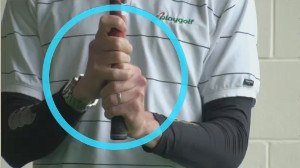
Unfortunately, most golfers grip the club with no more care than they'd take to grab a mop. Their hands akimbo, at odds with each other and squeezing the handle with vise-like pressure, they inhibit their power and accuracy before the swing even starts.
Bottom line: A proper golf grip is vital to making a good or perfect golf swing.
Of course, that raises an obvious question: What is a proper golf grip? The obvious answer: It depends on the player. Whatever grip helps him or her deliver the clubface squarely to the ball with maximum speed is correct and proper golf grip.
But that's not exactly helpful insight. Better to look at the common ingredients all good grips share, regardless of their style or position.
First and foremost, the palms face each other directly. This allows the hands to work in unison rather than letting one dominate. A sound proper golf grip allows the wrists to hinge freely, up and down, on the backswing, downswing and follow-through.
In a proper golf grip, the perfect placement of the palms and fingers permits freedom of movement and promotes feel without excess hand/wrist action. And grip pressure is light enough to prevent tension in the arms, firm enough to keep a solid correct hold on the club.
Aside from those common elements, many good grips are as different as night and day. Let's examine the various grip styles and positions, then go step-by-step through the gripping process.
The Three Grip Styles
Nearly all golfers hold the club using one of three methods. The main difference between the three is the placement of the right pinky finger (left pinky for left-handed golfers). In all three grips, the left thumb is extended down the handle between the right fingers and thumb pad.
- Overlapping or Vardon grip: The right little finger is placed on top of the crease between the left index and middle fingers. British golf legend Harry Vardon popularized this method in the early 20th century, and it remains the most widely used style among amateurs and pros.
- Interlocking grip: The right pinky is wedged (locked) between the left index and middle fingers. Many famous golfers have used the interlocking grip, including Jack Nicklaus, Tiger Woods and Rory McIlroy.
- Baseball grip: Many novice golfers employ this grip style, though very few experienced players do. The right pinky is not overlapped or interlocked with the left hand, but simply placed next to the left index finger on the handle.
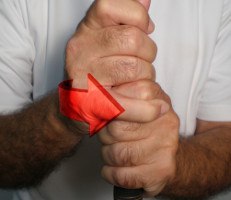
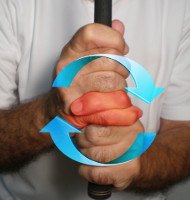

The Three Grip Positions
Not to be confused with grip type or style, grip position describes where the hands are placed on the handle relative to the clubface and target.
- Neutral: The hands/palms are directly aligned with the clubface, perpendicular to the target line. With a neutral grip, you can see 2 – 2 ½ knuckles on the back of the left hand at setup.
- Weak: The hands are rotated left (toward the target). With a weak grip, you can see fewer than two full knuckles on the back of the left hand.
- Strong: The hands are rotated right (away from the target). With a strong grip, you can see more than 2 ½ knuckles on the back of the left hand.

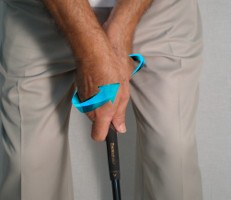
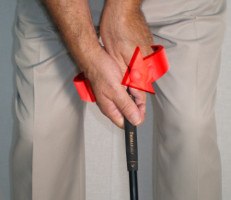
How to Take Your Golf Grip
Most golf instructors teach their students to grip the club with the left hand first, then the right hand. Here's how it's done.
Left Hand
- Cradle the handle in your fingers, leaving a space of ½” – 1” between the top of the grip and your hand. (This enhances your control of the club.) The underside of the grip should cross the middle of your index finger and run diagonally to the base of your pinky.
- Close your fingers and wrap your palm around the top of the grip, with the thumb running down the handle. The thumb should be slightly right of center as you look down.
- Place the club on the ground as though addressing a ball. Ideally, you'll see 2 – 2 ½” knuckles on the back of your left hand, meaning you're in a neutral position. More knuckles and your grip is on the strong side; fewer and you're grip is weak.
Right Hand
- With your left hand in place, wrap your right fingers around the underside of the grip. Your right pinky placement depends on the style of grip you're using (overlapping, interlocking or baseball, described above).
- Place the right thumb pad on top of the left thumb, squeezing lightly.
- Your right index finger should be slightly separated from the middle finger, squeezing the handle in a trigger-like manner.
- Once you've secured both hands to the club, release them so that your palms are flat against the handle. The palms should face each other directly.
One final note: Make sure not to grip the club too tightly. On a scale of 1 – 10, with 1 being extremely light and 10 extremely tight, your grip pressure should be about 4 or 5.
Your grip is the only connection that you have between your body and the club.
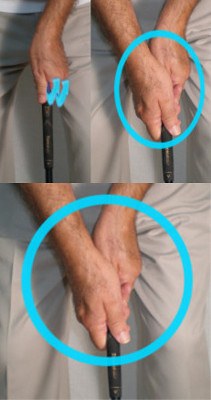
That might be obvious, but it is still something to think about as you work on your technique. For all of the time and effort you put into things like your swing path, stance, posture, etc. – none of it matters if the quality of your swing is lost between your hands and the club. Only when the moves you make with your body are translated perfectly to the club will you actually achieve the results you desire.
With this article, we are going to attempt to motivate you to get out and work on your grip. By highlighting the various reasons that the grip is important, we hope to cause you to practice this part of your technique just as much as you practice other elements. If you care enough about golf to head to the driving range for regular practice sessions, you should care enough to work on building a proper grip.
Of course, we aren't going to leave you with just motivation, as motivation alone isn't going to get you very far. Towards the end of the article, we will also outline some basic grip fundamentals that you can use as a starting point for your practice sessions. We aren't going to be able to touch on everything that you should watch for in your grip, but we will touch on the main keys.
It should be pointed out that working on your grip is a personal process. Yes, you should obey some basic fundamentals which are commonly accepted in this game, but you also need to trust your own instincts. If the club doesn't feel comfortable and natural in your hands, it won't matter how fundamentally-sound your grip may be – it isn't going to get the job done. You need to trust your grip, and that only happens when you feel comfortable with the way your hands are wrapped around the club. In the end, you will only be successful when you manage to blend a respect for the fundamentals of the grip with your own personal preferences.
All of the content below is based on a right-handed golfer. If you happen to play golf left-handed, please take a moment to reverse the directions as necessary.
The Full Swing Benefits of a Great Grip

It is hard to play good golf without a reliable full swing. Sure, the short game is extremely important – and we will get to it in a moment – but we are going to start with the full swing. If you can count on your swing to produce reasonably predictable results swing after swing, you will be in great shape. You don't have to be the best ball striker in the world to play well, but you do need to be able to send the ball in the general direction of the target more often than not.
So, how can a great grip help you make a better full swing? Let's take a look.
- Secure control of the club. When you swing through impact, you want to make sure that you have complete control over the golf club. This is important because it will help prevent – or, at least, limit – club head twisting at the moment of impact. However, you don't want to squeeze tightly on the grip during your swing, since that it going to cause you to lose swing speed. So, in the end, it is essential to have a fundamentally-sound grip which keeps the club secure in your hands without excess grip pressure.
- Play a variety of shots. Some golfers, mostly those who use an extreme grip, struggle to produce more than one kind of shot. For instance, a player who uses an extremely strong grip may be adept at hitting a draw, but it might be nearly impossible for that same player to hit a fade. However, if you use a moderate grip, you should be able to turn the ball in either direction, based on the demands of the course. This is a huge advantage. As you are working on building your grip, or making changes to your current grip, keep this flexibility in mind. You need to find a grip which works for you, of course, but keep that grip as close to neutral as possible. If you can manage to produce quality shots without having to resort to an extreme grip position, doing so would be in your best interest.
- Handle a number of different lies. Your grip is also important in terms of how it lets you handle different situations you encounter on the course. Hopefully, you'll get to play most of your shots from good lies – but even the best golfers have to deal with bad lies from time to time. When you run into a tricky spot, having a solid grip is going to help you manage that shot more successfully. Playing from the rough is a perfect example of this concept. With a good grip, you can swing through the rough without having to worry too much about the club head being dramatically thrown off line. It may twist a bit, but you should be able to carry it through the ball pretty well. A player with a poor grip would not have such a luxury.
- Feel confident. It is important to have confidence on the golf course, and using a grip that you can trust is going to go a long way toward boosting your belief in yourself. You will know that your hands are in the right position on the club before each swing, and you'll know what kinds of shots you are capable of producing. No golfer hit a good shot each time he or she makes a swing, but starting with a good grip will put you a bit ahead of the game. If you can blend that good grip with a collection of other solid fundamentals, you will be well on your way to a swing you can trust – even under pressure.
As you can see, there is a lot to like about having a proper grip to support your full swing. It is worth noting here that it may take a while to create this reliable grip. On the range, work on finding a grip position that feels good and seems to produce the kinds of shots you would like to hit. Then, continue to practice with that grip, getting more and more comfortable with each shot you send down the range. The grip you use is largely about feel, and the only way to develop a good feel for your grip is to use it over and over again. There are no shortcuts in this game, so expect to work your way through some struggles before you see the hard work you have put into your grip start to pay off.
The Short Game Benefits of a Great Grip
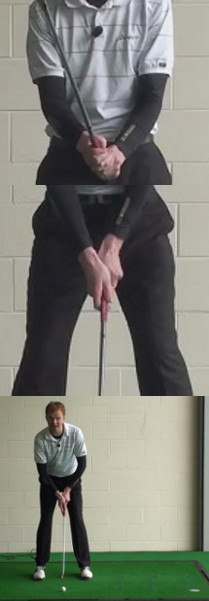
Believe it or not, the grip you use in the short game may be just as important as the grip you deploy for the full swing, if not more so. The short game requires you to blend distance control and accuracy perfectly, something that is simply not going to be possible with a bad grip. Fortunately, there is a lot of room for personal preference here, so you don't have to adhere to many fundamental rules in order to achieve good results.
Let's take a look at how your short game may be able to benefit if you work on improving the performance and consistency of your grip.
- Better touch. This is one of the main motivations for refining your short game grip. 'Touch', in golf terms, refers to your ability to hit the ball with the right speed for a given shot. For example, a golfer who has good touch on the greens is one who can roll the ball the appropriate distance with his or her putter, time and time again. Needless to say, this is a very valuable skill. While it is also important to be able to hit the ball on the right line, everything starts with touch in the short game. If you can send the ball the right distance with your putter as well as your wedges, you will never be far from good results. Of course, countless amateur players struggle to develop good touch, so you'll likely be well ahead of your playing partners if you can improve in this area.
- Control over the club face. You don't have to worry about the ball hooking or slicing when hitting short game shots. Even on a pitch shot, the ball isn't in the air long enough to actually turn as it flies. So, your only job is to point the club face at the target line at the point of impact. If you do that successfully, you can be sure that the ball is going to travel in the correct direction. Repeating the positioning of your club face is easier said than done, however, especially if you have a bad grip. When your grip is sound, you should find that it becomes easier to match up the face of the club with your intended target line, and it will be easier to hit good shots as a result.
- Make clean contact. This point is not so important on the greens with the putter, but it is critical when chipping from the side of the green with one of your wedges. You need to contact your chip shots cleanly to get them up in the air and headed toward the target. If you hit the ball fat, it will almost always come up short of your intended landing spot. Or, if you hit it thin, it won't get up into the air at all. Either way, the results are going to be disappointing. By building a solid grip that allows you to swing your wedges comfortably while chipping, it will get much easier to strike the ball cleanly. Specifically, you want to use a grip which allows your left wrist to get into a flat and firm position at the point of contact. Countless amateur golfers fall short on this point, and they struggle to chip consistently as a result.
It is worth noting that you will likely use two different grips in your short game – one for chip/pitch shots, and one for putts. The mechanics of a chip shot are much different than the mechanics of a putt, so it only makes sense that you would vary your grip to match. As you work on your putting grip, remember that you don't want to be using much hand action while swinging the putter. A grip which takes control out of your hands and stabilizes the stroke is a good thing. Then, when working on your chipping grip, you want to give power back to your hands and wrists, so you can hit through the ball properly. Most likely, the grip you use while chipping is going to be very similar – if not identical – to your full swing grip.






